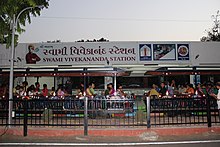Sayaji Baug
This article needs additional citations for verification. (March 2011) |
Sayaji Baug (also known as Kamati Baug) is a garden located in
Description








Sayaji Baug was dedicated to the citizens of Vadodara by
There are three entrance gates. The main gate is at Sayaji Circle (informally known as "Kala Ghoda Chowk" or "black horse circle" because of an equestrian statue standing there). This gate is only 800 metres (2,600 ft) from the main city railway station and even less from the city bus stand. The third gate is at Rana Pratap square in Fatehganj area, and the second gate stands somewhere in between first and third gates.
Highlights
Statues of the Two brave boys of Dhari
The Arjan Koli and Hari Koli were two Koli brothers from Dhari town. They saved the life of Maharaja Sayajirao Gaekwad III of Baroda State from a lion during hunting in 1933. After that both brothers were respected in open court (Baroda state darbar) and their bronze statues were established in royal Sayaji Baug (Kamati Baug) by Sayajirao Gaekwad.[1]
Baroda Museum & Picture Gallery

The museum was built in 1894 to resemble the
Sardar Patel Planetarium
The planetarium is situated near the main gate of Sayaji Baug. It is a pyramid-shaped building with a capacity of 200 spectators. It has daily public shows as well as offering special shows to educational institutions. it has shows in Hindi, English and Gujarati. The planetarium also gives you information about a variety of planets and stars.[2]
Show Name :- Saur Pradshan
| Monday to Sunday (closed Thursdays) | Language |
|---|---|
| 4:00 pm to 4:30 pm | Gujarati
|
| 5:00 pm to 5:30 pm | English |
| 6:00 pm to 6:30 pm | Hindi
|
Toy train

The toy train ride used to run on a track of width 10 inches (250 mm) covering a distance of 3.5 km (2.2 mi) giving the entire view of the garden to riders. The ride was a gift to the children of Vadodara from the royal Gaekwad dynasty.
Now a new train has been introduced instead of this small toy train. Its name is joy train in which even adults can sit. Joy train is bigger than the toy train. A new platform "Swami Vivekananda Station" is created for this train. The train timings are from 10 A.M. to 10 P.M. and it is closed on Thursdays. During the full journey of about 20 minutes the people are informed about the heritage of Vadodara and that of Kamati baug(garden) through speakers in the train.
The video for the popular song "Chakke pe Chakka, Chakke pe Gadi..." by
The zoo and aquarium
The Sayaji Baug Zoo, situated on both the banks of the
An aquarium was added to the zoo in 1962. It contains 45 species of fish.
Floral clock
The floral clock was the first of its kind in the state. It consists of an hour, minute and seconds hand that move on the 20 ft (6.1 m) diameter dial. The machinery moving the clock is underground, giving the clock a natural look.
The floral clock was designed by Ar. Prakash Pethe, who later served as the Town Development Officer for the Vadodara Municipal Corporation.
References
- ^ "Know Your City: How Baroda's bronze statues will regain their black sheen in Rs 1.10 crore restoration project". The Indian Express. 18 February 2024. Retrieved 19 April 2024.
- ^ "Vadodara Municipal Corporation".
